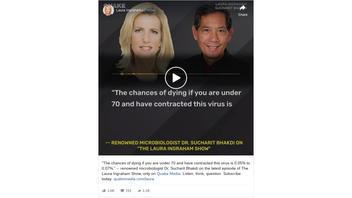
Does a Stanford professor's study conclude that people under 70 years of age only have a 0.05% to 0.07% chance of dying from the novel coronavirus? Yes, that's true, but the professor, a medical doctor with an expertise in epidemiology, estimates patients under 70 account for 20% of the deaths in the United States, which adds up to about 60,000 Americans dead from COVID-19 by December 15, 2020. Dr. John P.A. Ioannidis cautioned people in this very large age grouping should not shrug off all concerns about catching the virus.
The claim appeared in video in a Facebook post (archived here) published December 11, 2020, under the title "'The chances of dying if you are under 70 and have contracted this virus is 0.05% to 0.07%.' -- renowned microbiologist Dr. Sucharit Bhakdi on the latest episode of The Laura Ingraham Show." Bhakdi says, at about the 45-second mark of the 1:17-minute video:
So, I tell you, go and read that paper because it will tell you that according to all the studies that have been conducted in the world, the chances of dying, if you are under 70, and have contracted this virus, is 0.05% to 0.07%.
This is what the post looked like on Facebook at the time of writing:
(Source: Facebook screenshot taken on Mon Dec 14 22:00:58 2020 UTC)
The claim is based on research by Dr. John P.A. Ioannidis of Stanford University's Prevention Research Center and a professor of epidemiology and population health. His research shows the relatively low COVID-19 fatality rates for under-70s vary by country, with rates in the United States being "a bit higher" than most western European countries.
Bhakdi refers to Ioannidis' paper, "Infection fatality rate of COVID-19 inferred from seroprevalence data," which was published online October 14, 2020, in the Bulletin of the World Health Organization. The Stanford University professor's research included analyzing 61 studies on COVID-19 seroprevalence, or research looking at the level of the virus in a given population as measured in blood serum. This is what Ioannidis' research concluded:
The infection fatality rate of COVID-19 can vary substantially across different locations and this may reflect differences in population age structure and casemix of infected and deceased patients and other factors. The inferred infection fatality rates tended to be much lower than estimates made earlier in the pandemic.
Lead Stories contacted Ioannidis to ask him if the video had properly depicted the findings of his research. This is how he responded in an email:
Yes, they are accurate. Across the data included from diverse locations around the world in the Bulletin of the WHO paper, the median infection fatality rate is 0.05%. Given that these studies are done mostly in locations that were hard hit, the actual global best estimate may be even a bit lower, e.g. 0.04%. We do see however substantial diversity across locations, ranging from 0.00% to 0.31%.
Ioannidis said COVID-19 infection rates varied "substantially" depending on the country, based on several factors. Among them are demographics, including the age distribution of the population and the proportion of nursing home residents with the novel coronavirus. He said the infection fatality rate among nursing home residents is "astronomically high, about 25%." He said another factor is the "use of effective treatments (e.g. dexamethasone), and the use of harmful treatments (e.g. hydroxychloroquine)." In his email, Ioannidis compared infection fatality rates in the U.S. to Western Europe:
In the USA about 20% of COVID-19 fatalities are in people <70, which is a bit higher than say most western European countries. So, the infection fatality rate for those <70 in the USA specifically is probably a bit larger than 0.05%, but probably not much so, 0.07% may still be a reasonable estimate.
Twenty percent of 302,000 -- the number of American COVID-19 deaths as of December 15, 2020 -- equals 60,400 people under 70 dead.
Ioannidis' paper focused on COVID-19 infection fatality rate studies published before September 9, 2020.
His findings are consistent with nearly all COVID-19 research that determines that the elderly are more likely to die from COVID-19 infection than their younger counterparts. For example, the Center for Disease Control and Prevention data shows that infected people 65 to 74 are 90 times more likely to die of the coronavirus than those in the 18 to 29 comparison group. A CDC spokeswoman wrote in an email to Lead Stories:
CDC has not published case fatality rates because we don't have an estimate yet of the proportion of cases that are asymptomatic.
Bhakdi is among a group of scientists that believe many governments have overreacted with such measures as stay-at-home orders, bans on indoor dining at restaurants, etc. aimed at curbing the spread of the virus. Bhakdi, retired head of the Institute for Medical Microbiology and Hygiene at the Johannes-Gutenberg-Universität in Mainz, Germany, also co-authored the best-selling book, "Corona False Alarm?" In the video, his comments are solely focused on Ioannidis' paper. However, social media claims misinterpreting low COVID-19 infection fatality rates and related research are common. They include those made in the Lead Stories' Fact Check: "The 99% COVID Survival Rate Is NOT Evidence Lockdowns Are About 'Control' Instead of Health"
Lead Stories asked Ioannidis about misperceptions regarding low COVID-19 infection fatality rates, including the mistaken belief that people under 70 shouldn't worry about becoming infected. He wrote:
My personal stance is that I don't want anyone to be infected, if possible, even though the risk is indeed very small in the non-elderly. If 'shouldn't worry' means 'don't panic', I fully agree. If 'shouldn't worry' is translated as 'go infect yourself', I disagree.
















